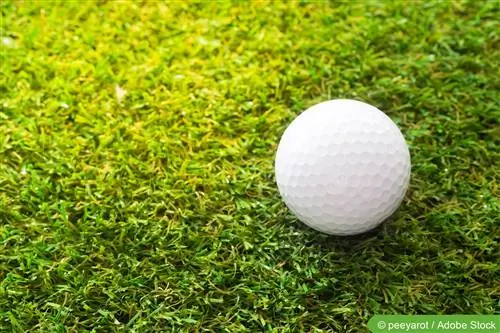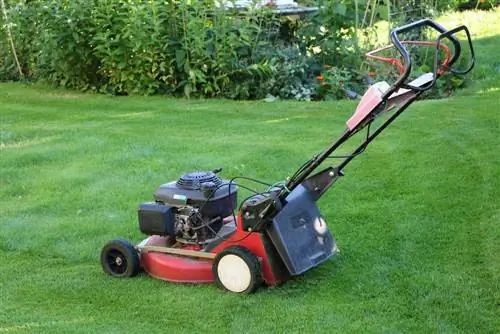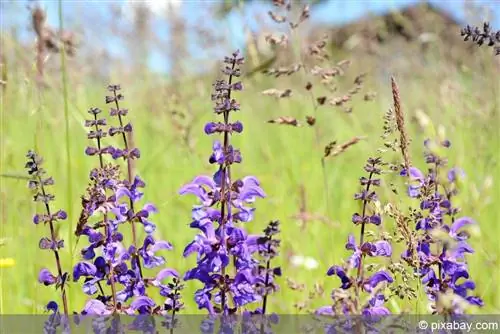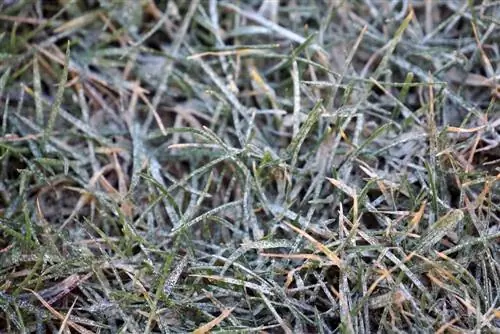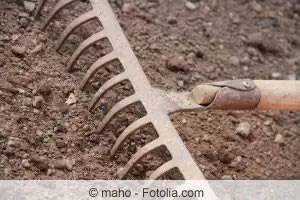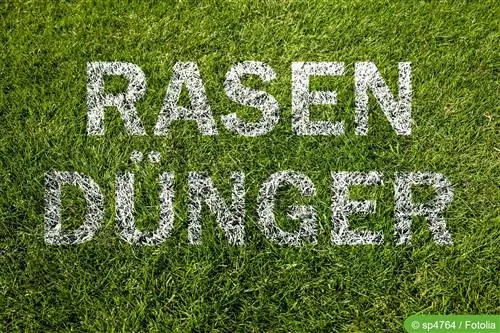- Author admin [email protected].
- Public 2023-12-17 03:39.
- Last modified 2025-01-24 12:45.
Lawn seed does not just consist of a single grass variety. Therefore, you will search in vain for the “golf turf” variety. Rather, it is a mixture of grass types that are suitable for creating a golf lawn. Only through intensive care can a green area like a golf course be created. Of course, the conditions under which the golf turf is to be created are also important factors for success. The interplay of sun and shade as well as the nature of the soil contribute significantly to success. Lawn seeds should therefore be selected carefully and be suitable for the location. The subsequent stress also plays a major role. With the right choice, you can also let your children play on the lawn if the sowing is durable.
Some examples of suitable lawn mixtures
There are manufacturers who offer special mixtures for golf courses and use their own names for them and usually do not reveal the exact composition. The RSM, standard seed mixtures, however, offer a good indication. Behind this name there is a whole set of rules for consistent lawn quality and originally comes from agriculture for fodder plants.
The RSM 4.3 consists of the following components:
- 20% red fescue
- 20% runner red fescue
- 20% meadow panicle (subspecies limousine)
- 15% meadow grass (subspecies Lisabelle or Lucius)
- 15% meadow grass (subspecies Lifrance or Orval)
- 10% Meadow panicle (subspecies Miracle)
The combination of the different types of lawn creates a durable scar with regenerative properties and is suitable for all locations, as the part that grows better at the location prevails. With such seed mixtures, the golf turf will not remain a dream if cared for appropriately.
No golf turf without nutrients
In nature, plant remains, worms and bacteria ensure that nutrients are returned to the soil. So humus is formed, which ensures a sufficient supply of nutrients. When caring for the golf turf, however, the natural formation of humus is eliminated because grass clippings and other plant residues are removed in favor of the density of the vegetation. Without nutrients, no plant will be able to grow, even with the best care. So a fertilizer has to replace the missing nutrients and minerals. To avoid growth spurts after fertilizing, a long-term fertilizer is recommended, as it releases the nutrients continuously over a period of up to three months.
Only a chemical soil analysis can provide information about exactly which nutrients are missing. Basically, the fertilizer used should always contain nitrogen, phosphorus (phosphates) and potassium. Other ingredients such as copper, iron, manganese and urea supplement the lawn's nutritional needs. If you want to use the humus obtained from lawn clippings as fertilizer, the humus should be supplemented with the same amount of sand. Otherwise, a pure humus application could suffocate the lawn plants. In addition, humus should be used sparingly to avoid short-term growth spurts.
Equally important is an even distribution of the fertilizer, whereby you should strictly adhere to the manufacturer's instructions. An oversupply is not as harmful as an undersupply, but it does cause a significant amount of extra work. When it comes to fertilizing, the motto “a lot helps a lot” is not true! If there is too much fertilizer, there is a possibility that the beautiful golf turf will burn due to sunlight.
In summer, fertilizing should also be carried out early in the morning or evening. If there are any doubts about the choice of fertilizer, you can consult a specialist or local gardener. He knows the local soil conditions best.
Conclusion: What you should know about golf turf
The demands placed on a golf turf are extremely high. This may be incomprehensible to non-golfers, but you certainly have to keep in mind that professional golf is largely about huge monetary winnings - and it is not uncommon for a golf tournament to be worth tens of thousands of euros. But even in so-called recreational golf, the participants in the game depend on perfect floor coverings. It therefore stands to reason that a lot of time, money and energy must always be invested in the daily maintenance of green spaces.
- The turf of every golf course must not only meet the strictest requirements in terms of appearance, but also absolute perfection in terms of the playability of the turf. For these reasons, it is essential for a golf turf to have resistant and absolutely robust properties. In plain language, this means that the corresponding golf turf can regenerate comparatively quickly after significant use and is fully usable again after a short period of time.
- These abilities are already determined in the seeds, although there are many different seed variants in this context. There are even varieties available that are specifically designed for the teeing area, while others are particularly suitable for frequently used areas of the course, such as: B. at the start of the fairway. There are also seed mixtures that are particularly suitable for slope areas and slopes, etc.
- In order to ensure a particularly intense, lush green as well as an extraordinarily high resilience of the golf turf, another important aspect is the type or composition of the fertilizers used. This depends on the nutrient requirements of the golf turf and must therefore be precisely tailored to this. Regular soil samples are therefore another must in order to be able to accurately determine the soil condition and nutrient content.

